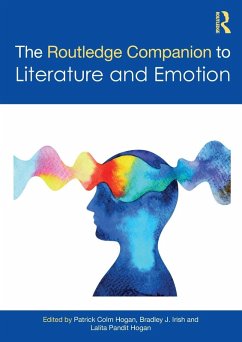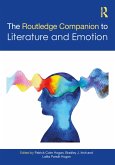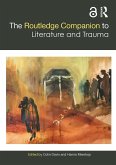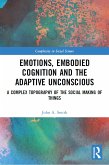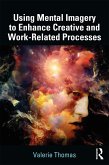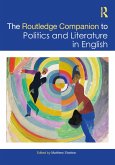The Routledge Companion to Literature and Emotion
Herausgeber: Hogan, Patrick Colm; Pandit Hogan, Lalita; Irish, Bradley J.
The Routledge Companion to Literature and Emotion
Herausgeber: Hogan, Patrick Colm; Pandit Hogan, Lalita; Irish, Bradley J.
- Broschiertes Buch
- Merkliste
- Auf die Merkliste
- Bewerten Bewerten
- Teilen
- Produkt teilen
- Produkterinnerung
- Produkterinnerung
This is a crucial guide to the ways in which new, interdisciplinary understandings of emotion and affect - in fields from neuroscience to social theory - are changing the study of literature and of the ways those new understandings are impacted by work on literature also.
Andere Kunden interessierten sich auch für
![The Routledge Companion to Literature and Emotion The Routledge Companion to Literature and Emotion]() The Routledge Companion to Literature and Emotion246,99 €
The Routledge Companion to Literature and Emotion246,99 €![The Routledge Companion to Literature and Trauma The Routledge Companion to Literature and Trauma]() The Routledge Companion to Literature and Trauma246,99 €
The Routledge Companion to Literature and Trauma246,99 €![The Routledge Companion to Literature and Trauma The Routledge Companion to Literature and Trauma]() The Routledge Companion to Literature and Trauma50,99 €
The Routledge Companion to Literature and Trauma50,99 €![Emotions, Embodied Cognition and the Adaptive Unconscious Emotions, Embodied Cognition and the Adaptive Unconscious]() John A. SmithEmotions, Embodied Cognition and the Adaptive Unconscious45,99 €
John A. SmithEmotions, Embodied Cognition and the Adaptive Unconscious45,99 €![The Routledge Companion to the Environmental Humanities The Routledge Companion to the Environmental Humanities]() The Routledge Companion to the Environmental Humanities53,99 €
The Routledge Companion to the Environmental Humanities53,99 €![Using Mental Imagery to Enhance Creative and Work-related Processes Using Mental Imagery to Enhance Creative and Work-related Processes]() Valerie ThomasUsing Mental Imagery to Enhance Creative and Work-related Processes37,99 €
Valerie ThomasUsing Mental Imagery to Enhance Creative and Work-related Processes37,99 €![The Routledge Companion to Politics and Literature in English The Routledge Companion to Politics and Literature in English]() The Routledge Companion to Politics and Literature in English238,99 €
The Routledge Companion to Politics and Literature in English238,99 €-
-
-
This is a crucial guide to the ways in which new, interdisciplinary understandings of emotion and affect - in fields from neuroscience to social theory - are changing the study of literature and of the ways those new understandings are impacted by work on literature also.
Produktdetails
- Produktdetails
- Routledge Literature Companions
- Verlag: Taylor & Francis Ltd
- Seitenzahl: 516
- Erscheinungstermin: 14. April 2025
- Englisch
- Abmessung: 246mm x 174mm x 28mm
- Gewicht: 890g
- ISBN-13: 9781032219226
- ISBN-10: 103221922X
- Artikelnr.: 73480604
- Herstellerkennzeichnung
- Libri GmbH
- Europaallee 1
- 36244 Bad Hersfeld
- gpsr@libri.de
- Routledge Literature Companions
- Verlag: Taylor & Francis Ltd
- Seitenzahl: 516
- Erscheinungstermin: 14. April 2025
- Englisch
- Abmessung: 246mm x 174mm x 28mm
- Gewicht: 890g
- ISBN-13: 9781032219226
- ISBN-10: 103221922X
- Artikelnr.: 73480604
- Herstellerkennzeichnung
- Libri GmbH
- Europaallee 1
- 36244 Bad Hersfeld
- gpsr@libri.de
Patrick Colm Hogan is Board of Trustees Distinguished Professor in the Department of English and the Program in Cognitive Science at the University of Connecticut, USA. Bradley J. Irish is Associate Professor of English at Arizona State University, USA. Lalita Pandit Hogan is Professor Emerita of English at the University of Wisconsin, La Crosse, USA.
Introduction. Literary Feelings: Understanding Emotions Part 1 Theoretical
Perspectives 1. Affective Neuroscience: The Symbiosis of Scientific and
Literary Knowledge 2. Affect Theory 3. Cognitive Linguistics: A Perspective
on Emotion in Literature 4. Cognitive Science: Literary Emotions from
Appraisal to Embodiment 5. Embodiment: Embodied Simulation and Emotional
Engagement with Literary Characters 6. Empirical Approaches to Studying
Emotion in Literature: The Case of Gender 7. Evolution: How Evolved
Emotions Work in Literary Meaning 8. The History of Emotions and Literature
9. Philosophy, Literature, and Emotion Part 2 Emotions of Literature 10.
Aesthetic Emotions 11. Paradoxes of Literary Emotion: Simulation and The
Zhào Orphan 12. Sympathy and Empathy 13. Tragedy and Comedy: Emotional
Tears and Trust in King Lear and Cymbeline Part 3 Literature and Emotion in
the World 14. Colonialism and Postcolonialism 15. Disability,
"Enslavement," and Slavery: Affective Historicism and Fletcher and
Masssinger's A Very Woman 16. Ecology and Emotion: Feeling Narrative
Environments 17. Morals: The Ethical Gangster 18. Gender, Emotion,
Literature: "No Woman's Heart" in Shakespeare's Twelfth Night 19. Race and
Ethnicity 20. Sexuality 21. Trauma and Its Future: Re-Visiting Aesthetic
Form Debates Part 4 Elements of Literary Structure and Experience 22.
Authors: Cognitive Patterns and Individual Creativity 23. Character and
Emotion in Fiction 24. Language, Style, and Texture 25. Narrative and Plot:
Unreliable Feelings and the Risks of Surprise 26. Readers 27. Social
Reception 28. Stories: Particular Causes and Universal Genres Part 5 Modes
of Literature 29. Drama: Feeling Out Loud in Shakespearean Apostrophe and
the History of Emotions 30. Film: The Affective Specificity of Audiovisual
Media 31. Graphic Fiction: BIPOC Teen Comics 32. Lyric 33. Prose Fiction
Part 6 Literary Examples 34. Geoffrey Chaucer 35. William Shakespeare:
Anxieties About Trust in The Tempest 36. Jane Austen and the Emotion of
Love 37. Virginia Woolf's Development of a Sociology of Emotion in the
Composition of The Years (1937)
38. Helon Habila: Structural Helplessness and the Quest for Hope in Oil on
Water
39. Viet Thanh Nguyen: Navigating Anger and Empathy in The Sympathizer
Perspectives 1. Affective Neuroscience: The Symbiosis of Scientific and
Literary Knowledge 2. Affect Theory 3. Cognitive Linguistics: A Perspective
on Emotion in Literature 4. Cognitive Science: Literary Emotions from
Appraisal to Embodiment 5. Embodiment: Embodied Simulation and Emotional
Engagement with Literary Characters 6. Empirical Approaches to Studying
Emotion in Literature: The Case of Gender 7. Evolution: How Evolved
Emotions Work in Literary Meaning 8. The History of Emotions and Literature
9. Philosophy, Literature, and Emotion Part 2 Emotions of Literature 10.
Aesthetic Emotions 11. Paradoxes of Literary Emotion: Simulation and The
Zhào Orphan 12. Sympathy and Empathy 13. Tragedy and Comedy: Emotional
Tears and Trust in King Lear and Cymbeline Part 3 Literature and Emotion in
the World 14. Colonialism and Postcolonialism 15. Disability,
"Enslavement," and Slavery: Affective Historicism and Fletcher and
Masssinger's A Very Woman 16. Ecology and Emotion: Feeling Narrative
Environments 17. Morals: The Ethical Gangster 18. Gender, Emotion,
Literature: "No Woman's Heart" in Shakespeare's Twelfth Night 19. Race and
Ethnicity 20. Sexuality 21. Trauma and Its Future: Re-Visiting Aesthetic
Form Debates Part 4 Elements of Literary Structure and Experience 22.
Authors: Cognitive Patterns and Individual Creativity 23. Character and
Emotion in Fiction 24. Language, Style, and Texture 25. Narrative and Plot:
Unreliable Feelings and the Risks of Surprise 26. Readers 27. Social
Reception 28. Stories: Particular Causes and Universal Genres Part 5 Modes
of Literature 29. Drama: Feeling Out Loud in Shakespearean Apostrophe and
the History of Emotions 30. Film: The Affective Specificity of Audiovisual
Media 31. Graphic Fiction: BIPOC Teen Comics 32. Lyric 33. Prose Fiction
Part 6 Literary Examples 34. Geoffrey Chaucer 35. William Shakespeare:
Anxieties About Trust in The Tempest 36. Jane Austen and the Emotion of
Love 37. Virginia Woolf's Development of a Sociology of Emotion in the
Composition of The Years (1937)
38. Helon Habila: Structural Helplessness and the Quest for Hope in Oil on
Water
39. Viet Thanh Nguyen: Navigating Anger and Empathy in The Sympathizer
Introduction. Literary Feelings: Understanding Emotions Part 1 Theoretical
Perspectives 1. Affective Neuroscience: The Symbiosis of Scientific and
Literary Knowledge 2. Affect Theory 3. Cognitive Linguistics: A Perspective
on Emotion in Literature 4. Cognitive Science: Literary Emotions from
Appraisal to Embodiment 5. Embodiment: Embodied Simulation and Emotional
Engagement with Literary Characters 6. Empirical Approaches to Studying
Emotion in Literature: The Case of Gender 7. Evolution: How Evolved
Emotions Work in Literary Meaning 8. The History of Emotions and Literature
9. Philosophy, Literature, and Emotion Part 2 Emotions of Literature 10.
Aesthetic Emotions 11. Paradoxes of Literary Emotion: Simulation and The
Zhào Orphan 12. Sympathy and Empathy 13. Tragedy and Comedy: Emotional
Tears and Trust in King Lear and Cymbeline Part 3 Literature and Emotion in
the World 14. Colonialism and Postcolonialism 15. Disability,
"Enslavement," and Slavery: Affective Historicism and Fletcher and
Masssinger's A Very Woman 16. Ecology and Emotion: Feeling Narrative
Environments 17. Morals: The Ethical Gangster 18. Gender, Emotion,
Literature: "No Woman's Heart" in Shakespeare's Twelfth Night 19. Race and
Ethnicity 20. Sexuality 21. Trauma and Its Future: Re-Visiting Aesthetic
Form Debates Part 4 Elements of Literary Structure and Experience 22.
Authors: Cognitive Patterns and Individual Creativity 23. Character and
Emotion in Fiction 24. Language, Style, and Texture 25. Narrative and Plot:
Unreliable Feelings and the Risks of Surprise 26. Readers 27. Social
Reception 28. Stories: Particular Causes and Universal Genres Part 5 Modes
of Literature 29. Drama: Feeling Out Loud in Shakespearean Apostrophe and
the History of Emotions 30. Film: The Affective Specificity of Audiovisual
Media 31. Graphic Fiction: BIPOC Teen Comics 32. Lyric 33. Prose Fiction
Part 6 Literary Examples 34. Geoffrey Chaucer 35. William Shakespeare:
Anxieties About Trust in The Tempest 36. Jane Austen and the Emotion of
Love 37. Virginia Woolf's Development of a Sociology of Emotion in the
Composition of The Years (1937)
38. Helon Habila: Structural Helplessness and the Quest for Hope in Oil on
Water
39. Viet Thanh Nguyen: Navigating Anger and Empathy in The Sympathizer
Perspectives 1. Affective Neuroscience: The Symbiosis of Scientific and
Literary Knowledge 2. Affect Theory 3. Cognitive Linguistics: A Perspective
on Emotion in Literature 4. Cognitive Science: Literary Emotions from
Appraisal to Embodiment 5. Embodiment: Embodied Simulation and Emotional
Engagement with Literary Characters 6. Empirical Approaches to Studying
Emotion in Literature: The Case of Gender 7. Evolution: How Evolved
Emotions Work in Literary Meaning 8. The History of Emotions and Literature
9. Philosophy, Literature, and Emotion Part 2 Emotions of Literature 10.
Aesthetic Emotions 11. Paradoxes of Literary Emotion: Simulation and The
Zhào Orphan 12. Sympathy and Empathy 13. Tragedy and Comedy: Emotional
Tears and Trust in King Lear and Cymbeline Part 3 Literature and Emotion in
the World 14. Colonialism and Postcolonialism 15. Disability,
"Enslavement," and Slavery: Affective Historicism and Fletcher and
Masssinger's A Very Woman 16. Ecology and Emotion: Feeling Narrative
Environments 17. Morals: The Ethical Gangster 18. Gender, Emotion,
Literature: "No Woman's Heart" in Shakespeare's Twelfth Night 19. Race and
Ethnicity 20. Sexuality 21. Trauma and Its Future: Re-Visiting Aesthetic
Form Debates Part 4 Elements of Literary Structure and Experience 22.
Authors: Cognitive Patterns and Individual Creativity 23. Character and
Emotion in Fiction 24. Language, Style, and Texture 25. Narrative and Plot:
Unreliable Feelings and the Risks of Surprise 26. Readers 27. Social
Reception 28. Stories: Particular Causes and Universal Genres Part 5 Modes
of Literature 29. Drama: Feeling Out Loud in Shakespearean Apostrophe and
the History of Emotions 30. Film: The Affective Specificity of Audiovisual
Media 31. Graphic Fiction: BIPOC Teen Comics 32. Lyric 33. Prose Fiction
Part 6 Literary Examples 34. Geoffrey Chaucer 35. William Shakespeare:
Anxieties About Trust in The Tempest 36. Jane Austen and the Emotion of
Love 37. Virginia Woolf's Development of a Sociology of Emotion in the
Composition of The Years (1937)
38. Helon Habila: Structural Helplessness and the Quest for Hope in Oil on
Water
39. Viet Thanh Nguyen: Navigating Anger and Empathy in The Sympathizer

